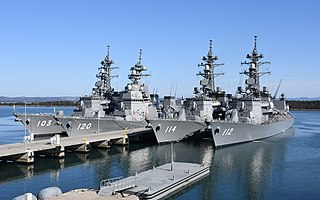
JDS Teruzuki (DD-162) was a Japanese Akizuki-class destroyer. The vessel was laid down in 1958 and served as a front line warship with the Japan Maritime Self-Defense Force until 1986, and as an auxiliary until 1993.

The Japan Maritime Self-Defense Force, abbreviated JMSDF, also simply known as the Japanese Navy, is the maritime warfare branch of the Japan Self-Defense Forces, tasked with the naval defense of Japan. The JMSDF was formed following the dissolution of the Imperial Japanese Navy (IJN) after World War II. The JMSDF has a fleet of 154 ships, 346 aircraft and 50,800 personnel.

The Hatsuyuki-class destroyer is a class of destroyer, serving with the Japan Maritime Self-Defense Force (JMSDF). It was the first class of first generation of general-purpose destroyers of the JMSDF.

The Asagiri-class destroyer is a class of destroyer, serving with the Japan Maritime Self-Defense Force (JMSDF). It was the second class of first-generation general-purpose destroyers of the JMSDF.

The Mitsubishi H-60 series is a twin-turboshaft engine helicopter based on the Sikorsky UH-60 helicopter family for use by the Japan Self-Defense Forces (JSDF).

JMSDF Tateyama Air Base is a military aerodrome of the Japan Maritime Self-Defense Force. It is located outside the city of Tateyama in Chiba Prefecture, Japan, at the southern tip of the Bōsō Peninsula.It also has a shorter runway because the airbase is only used for helicopters and planes only fly to Kisarazu airfield which is the only base nearby

JS Mineyuki (DD-124) was a Hatsuyuki-class destroyer of the Japanese Maritime Self-Defense Force.

JS Shirayuki (DD-123/TV-3517) was a Hatsuyuki-class destroyer of the Japan Maritime Self-Defense Force. The ship was commissioned in 1982.

The JMSDF Ōminato Naval Base is a Japan Maritime Self-Defense Force naval base with port and military aerodrome facilities. It is located on Mutsu Bay in the city of Mutsu in the Aomori Prefecture, in extreme northern Honshū, Japan.

JS Suzutsuki (DD-117) is the third ship of Akizuki-class destroyers, operated by the Japan Maritime Self-Defense Force. She was commissioned on 12 March 2014.
Hefei (174) is a Type 052D destroyer of the People's Liberation Army Navy. She was commissioned on 12 December 2015.

JS Asagiri (DD-151) is an Asagiri-class destroyer of the Japan Maritime Self-Defense Force, and is the oldest warship in commission in the JMSDF.

JS Umigiri (DD-158) is an Asagiri-class destroyer of the Japan Maritime Self-Defense Force.

JS Yūgiri (DD-153) is an Asagiri-class destroyer of the Japan Maritime Self-Defense Force.

JS Sawagiri (DD-157) is an Asagiri-class destroyer of the Japan Maritime Self-Defense Force.

JS Setogiri (DD-156) is an Asagiri-class destroyer of the Japan Maritime Self-Defense Force.

JS Hamagiri (DD-155) is an Asagiri-class destroyer of the Japan Maritime Self-Defense Force.

JS Hamayuki (DD-126) was a Hatsuyuki-class destroyer of the Japanese Maritime Self-Defense Force.

JS Isoyuki (DD-127) was a Hatsuyuki-class destroyer of the Japanese Maritime Self-Defense Force.

JS Asayuki (DD-132) was a Hatsuyuki-class destroyer of the Japanese Maritime Self-Defense Force.



























